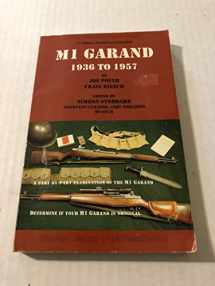
The M1 Garand, 1936-1957
Book details
Summary
Description
New, 6th Edition, revised and expanded with new serial number information, parts descriptions, and photos.
The M1 Garand was the battle rifle issued to American forces during World War II and the Korean War. It was the first semiautomatic rifle design to be used by combat forces in any army of the world. It was standardized in 1936 and saw its first combat in the Philippines in December 1941. Few other rifles have developed such a distinguished record as both a battle rifle and a match target rifle. General George Patton called the M1 Garand the greatest battle implement ever devised. The semiautomatic M1 Garand gave the American soldier a distinct firepower advantage over enemy soldiers armed with bolt action rifles that had to be cocked before each shot. During World War II, nearly four million M1 Garands were built at the Springfield National Armory and Winchester Repeating Firearms factories. They were issued in every theater of the war. And hundreds of thousands were issued to French, Belgian, Greek, Italian and Philippine allies as well. During the Cold War years until the early 1960s, the M1 Garand was the mainstay of our small arms support programs to allied and friendly nations. In the last days of World War II, special variations of the M1 Garand, designated the M1C were developed and produced as sniper rifles. More were built during and after the Korean War as the M1D. Also, during the Korean War, the M1 Garand was put back into production at Springfield, and in the factories of two private concerns, bringing the total production to almost 6,000,000. Hundreds of thousands of M1 Garands were issued to soldiers of the Army of the Republic of South Vietnam. Thousands of M1 Garands were manufactured in the 1950s as Match Target rifles and these are also eagerly sought by collectors.
After Congress approved the reimportation of certain military rifles for collecting purposes in 1986, it is estimated that nearly half a million of the 1.5 to 2 million M1 Garands shipped overseas to allied and friendly nations were allowed to be reimported. Collector's snapped them up eagerly and began to restore them to original condition. But the M1 Garand had undergone a such continuous process of improvement and upgrading that by the end of production in 1955, hardly a single part remained as it had originally been designed.
The collector attempting to restore an M1 Garand to original, as-manufactured condition must first determine when his rifle was manufactured, then which part or parts need replacing. Keep in mind that there were four different manufacturers of the rifle, all of whom also made spare parts.
Fortunately, every part of the M1 Garand carries at least one clue to its manufacturer and the date when it was made. Every major part was stamped with a part number; and these part numbers were changed every time the part was redesigned for improvement. Other clues are the type and color of finish, specific machine tool marks, factory codes and so on, all translated in The M1 Garand: 1936 to 1957. With this book in hand, the collector will find it easy to examine his or her rifle and determine which parts must be replaced to return it to its original state. The book also explains how to determine if replacement parts are correct and if they are of original manufacture or are so-called after-market parts of non-military origin.
The book also describes in detail, the m1 Garand M1C, M1D,and MC-52 Sniper Rifles and the M1 Garand National Match Rifles.


We would LOVE it if you could help us and other readers by reviewing the book
Book review



